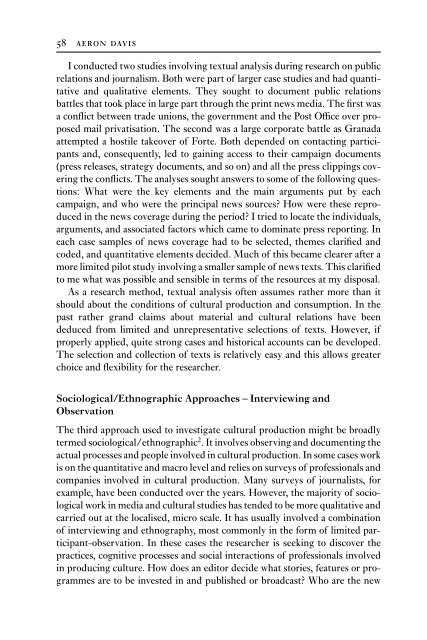Research Methods for Cultural Studies
Research Methods for Cultural Studies
Research Methods for Cultural Studies
Create successful ePaper yourself
Turn your PDF publications into a flip-book with our unique Google optimized e-Paper software.
58 aeron davis<br />
I conducted two studies involving textual analysis during research on public<br />
relations and journalism. Both were part of larger case studies and had quantitative<br />
and qualitative elements. They sought to document public relations<br />
battles that took place in large part through the print news media. The first was<br />
a conflict between trade unions, the government and the Post Office over proposed<br />
mail privatisation. The second was a large corporate battle as Granada<br />
attempted a hostile takeover of Forte. Both depended on contacting participants<br />
and, consequently, led to gaining access to their campaign documents<br />
(press releases, strategy documents, and so on) and all the press clippings covering<br />
the conflicts. The analyses sought answers to some of the following questions:<br />
What were the key elements and the main arguments put by each<br />
campaign, and who were the principal news sources? How were these reproduced<br />
in the news coverage during the period? I tried to locate the individuals,<br />
arguments, and associated factors which came to dominate press reporting. In<br />
each case samples of news coverage had to be selected, themes clarified and<br />
coded, and quantitative elements decided. Much of this became clearer after a<br />
more limited pilot study involving a smaller sample of news texts. This clarified<br />
to me what was possible and sensible in terms of the resources at my disposal.<br />
As a research method, textual analysis often assumes rather more than it<br />
should about the conditions of cultural production and consumption. In the<br />
past rather grand claims about material and cultural relations have been<br />
deduced from limited and unrepresentative selections of texts. However, if<br />
properly applied, quite strong cases and historical accounts can be developed.<br />
The selection and collection of texts is relatively easy and this allows greater<br />
choice and flexibility <strong>for</strong> the researcher.<br />
Sociological/Ethnographic Approaches – Interviewing and<br />
Observation<br />
The third approach used to investigate cultural production might be broadly<br />
termed sociological/ethnographic 2 . It involves observing and documenting the<br />
actual processes and people involved in cultural production. In some cases work<br />
is on the quantitative and macro level and relies on surveys of professionals and<br />
companies involved in cultural production. Many surveys of journalists, <strong>for</strong><br />
example, have been conducted over the years. However, the majority of sociological<br />
work in media and cultural studies has tended to be more qualitative and<br />
carried out at the localised, micro scale. It has usually involved a combination<br />
of interviewing and ethnography, most commonly in the <strong>for</strong>m of limited participant-observation.<br />
In these cases the researcher is seeking to discover the<br />
practices, cognitive processes and social interactions of professionals involved<br />
in producing culture. How does an editor decide what stories, features or programmes<br />
are to be invested in and published or broadcast? Who are the new


